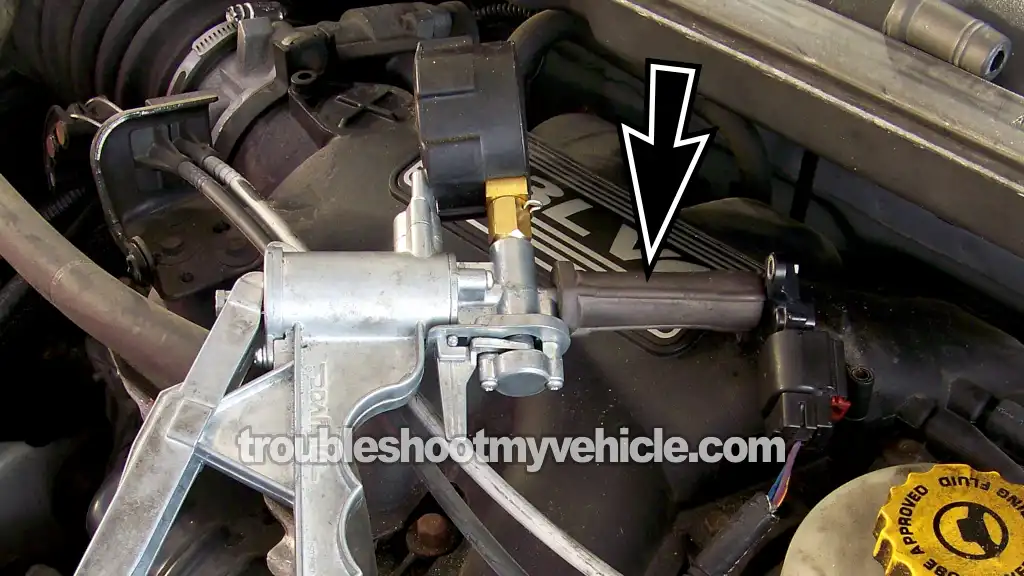
I'm gonna' show you the absolutely best way (and probably one of the most accurate ways) of testing the manifold absolute pressure (MAP) sensor on your 3.3L equipped Chrysler/Dodge mini-van.
Before we get started, let me tell you that this tutorial will show you how to do a MAP sensor bench test. You'll need a vacuum pump, that you can rent at your local auto parts store (AutoZone, O'Reilly) and can be accomplished in a few minutes.
If you don't have access to a vacuum pump, no big deal, you can just just the good ole lungs (more about this in the tests).
Now, in case you're wondering, “Why a bench test?”, this is due to the fact that so many different conditions can trick the fuel injection computer (PCM = Powertrain Control Module) into thinking the MAP sensor is bad when it isn't. So, the best way to find out if the MAP sensor is truly fried or not is by testing it off of the engine.
Contents of this tutorial:
ES ![]() You can find this tutorial in Spanish here: Cómo Probar El Sensor MAP (2001-2004 3.3L Chrysler) (at: autotecnico-online.com).
You can find this tutorial in Spanish here: Cómo Probar El Sensor MAP (2001-2004 3.3L Chrysler) (at: autotecnico-online.com).
APPLIES TO: This tutorial applies to the following vehicles:
- 3.3L V6 Chrysler Town and Country: 2001, 2002, 2003, 2004.
- 3.3L V6 Chrysler Voyager: 2001, 2002, 2003.
- 3.3L V6 Dodge Caravan: 2001, 2002, 2003, 2004.
- 3.3L V6 Dodge Grand Caravan: 2001, 2002, 2003, 2004.
OTHER MAP SENSOR TESTS:
- How To Test The MAP Sensor (1991-1995 3.3L V6 Caravan, Grand Caravan, Voyager, Grand Voyager).
- How To Test The MAP Sensor (1996-2000 3.3L V6 Caravan, Grand Caravan, Voyager, Grand Voyager, Town & Country).
Symptoms Of A Bad MAP Sensor
When the manifold absolute pressure (MAP) sensor fails, the check engine light will turn on and you'll see one of the following diagnostic trouble codes:
- P0106: MAP System Performance.
- P0107: MAP Sensor Circuit Low Voltage.
- P0108: MAP Sensor Circuit High Voltage.
Besides the diagnostic trouble codes, your Chrysler/Dodge 3.3L mini-van is not gonna' run right. You'll experience one or several of the following symptoms:
- Rough idle.
- Black smoke coming out of the tail-pipe.
- Engine stalls under load.
- Engine dies as soon as it starts.
- Lack of power when you accelerate the vehicle down the road.
MAP sensors go bad all of the time but sometimes some other condition (affecting engine performance) fools the PCM (Powertrain Control Module = Fuel Injection Computer) into thinking that the MAP sensor is has failed.
To be absolutely sure the MAP sensor is bad or not (without replacing to find out), you need to bench test it and the MAP sensor test that I'm gonna' show you is a MAP sensor bench test.
If after doing the MAP sensor test and the MAP sensor is good, then take a look at the section: MAP Sensor Code Won't Go Away.
How The MAP Sensor Works

The fuel system in your 3.3L equipped Chrysler mini-van is a ‘speed density’ type. Which, among other things, means it doesn't use a mass air flow (MAF) sensor to measure the amount of air the engine is breathing.
To be a bit more specific, the PCM uses the MAP sensor to measure the amount of vacuum inside the engine, the intake air temp sensor, and the crank sensor (to know the engine's RPMs) to calculate the amount of air entering the engine.
This is what happens when you turn the key and start the engine:
- MAP sensor power up: The PCM feeds 5 Volts and Ground to the MAP sensor:
- Power is supplied thru' the wire labeled with the number 3.
- Ground is provided, by the PCM too, thru' the wire labeled with the number 2.
- Intake manifold pressure measurements: Once the MAP sensor gets power and Ground, it now starts to measure the amount of vacuum the engine is producing.
- PCM receives the MAP data: The MAP signal is sent to the PCM thru' the wire labeled with the number 1.
- Fuel management: With both the MAP sensor, IAT sensor and CKP sensor signals, the PCM now calculates the approximate amount of air entering the engine and:
- Adjusts fuel injection pulse width.
- Adjusts ignition timing.
The MAP sensor plays a pretty significant role in the performance and efficient operation of the engine in your 3.3L equipped Chrysler or Dodge mini-van. Let's get testing.
Where To Buy The MAP Sensor And Save
The following links will help you comparison shop for the MAP sensor. All of the MAP sensors are from known automotive brands (no cheap knock-off sensors):
Disclosure: As an Amazon Associate, I earn from qualifying purchases. If my tutorials help you, using these links is an easy way to support the site at no extra cost to you. Thank you!
Not sure if the above MAP sensor fits your particular mini-van? Don't worry. Once you get to the site they'll make sure it fits. If it doesn't, they'll find you the right one.
TEST 1: Checking The MAP Signal
The very first thing you need to do, is remove the MAP sensor from the intake manifold (remember, we're gonna' bench test it).
Once removed, reconnect it to its electrical connector, since we'll let the PCM power it up for us (while we test it).
The next step will to see if the MAP sensor is able to create a good MAP signal. This is done using a vacuum pump while the MAP sensor is still connected electrically to the vehicle.
If you don't have a vacuum pump, you have two options: 1.) Rent one from AutoZone or O'Reilly Auto Parts or 2.) Use your mouth to suck on the MAP sensor via a vacuum hose (using the good ole' lungs is not the most accurate way, but it does work).
OK, to get this show on the road, this is what you need to do:
- 1
Remove the MAP sensor from its spot on the intake manifold.
- 2
Connect the MAP sensor to the vacuum pump. The vacuum hose that you need to use has to fit tightly around both the vacuum pump and MAP sensor's vacuum port.
I used a spark plug wire boot that I removed from an old spark plug wire to connect my vacuum pump to the MAP sensor (see photo 2 of 2 in the image viewer above). - 3
Connect the black multimeter test lead directly to the battery negative (-) post.
- 4
Set your multimeter to Volts DC mode.
- 5
Connect the red multimeter test lead to the wire labeled with the number 1 (see the image above).
NOTE: Remember, the MAP sensor must remain connected to its 3-wire connector. - 6
Turn the key on but don't start the engine.
This will enable the manifold absolute pressure (MAP) sensor to get power in the form of 5 Volts from the PCM (Powertrain Control Module = Fuel Injection Computer). - 7
With the Key On Engine Off (KOEO) and without any vacuum applied to the MAP sensor your multimeter should register about 4.5 to 5 Volts DC.
- 8
Apply vacuum to the sensor with the vacuum pump (or your mouth).
- 9
Your multimeter should register a decreasing voltage.
This voltage can go as low as 1.5 Volts or less. - 10
Release the vacuum.
- 11
The MAP voltage should go up to the voltage you saw at the beginning of the test (about 4.5 Volts).
- 12
Repeat steps 8 thru' 11 a couple of times to make sure of your test result.
OK, let's take a look at what your results mean:
CASE 1: Your multimeter displayed a decreasing voltage signal as you pumped up the vacuum. Your multimeter test results confirm that the manifold absolute pressure (MAP) sensor is OK and working like it should. No further testing is required.
Now, if your vehicle still has the MAP sensor code lighting up the check engine on your instrument cluster, take a look at the section: MAP Sensor Code Won't Go Away for more info.
CASE 2: Your multimeter DID NOT display a decreasing voltage signal as you pumped up the vacuum gauge. This usually confirms that the manifold absolute pressure (MAP) sensor on your 3.3L V6 Chrysler (Dodge) mini-van is bad.
To be absolutely sure, I suggest confirming that the MAP sensor has power and Ground. If both (power and Ground) are present, the MAP is bad. To test for power, go to: TEST 2: Verifying The MAP Sensor Has Power.
CASE 3: Your multimeter DID NOT register any voltage. This usually means that the MAP sensor is fried.
To be absolutely sure, I suggest confirming that the MAP sensor has power and Ground. If both (power and Ground) are present, the MAP is bad. To test for power, go to: TEST 2: Verifying The MAP Sensor Has Power.
TEST 2: Verifying The MAP Sensor Has Power

You've reached this point, because in TEST 1, you have confirmed that the MAP sensor on your Chrysler 3.3L mini-van is not creating a MAP signal or the MAP signal is erratic.
The next test step is to verify that the MAP sensor is getting power, since without power it won't work. This power come in the form of 5 Volts and the PCM (Powertrain Control Module = Fuel Injection Computer) is the one that provides this juice.
Alright, this is what you'll need to do:
- 1
Disconnect the MAP sensor from its connector.
- 2
Ground the black multimeter test lead on the battery's negative post.
- 3
Set your multimeter to Volts DC mode.
- 4
Turn the key to the ON position (but engine OFF).
- 5
Probe the front of the terminal that connects to the wire labeled with the number 3 with the red multimeter test lead.
- 6
Your multimeter should register 4.5 to 5 Volts DC.
Let's take a look at what your results mean:
CASE 1: The multimeter registered 5 Volts. This is the correct result and it's starting to look like the MAP sensor is bad but you still need to check that the MAP sensor is getting Ground. For the Ground test, go to: TEST 3: Verifying The Ground Circuit.
CASE 2: The multimeter DID NOT register 5 Volts. This results lets you know that the MAP sensor is not bad, since without these 5 Volts DC, the MAP sensor can not function.
Although it's beyond the scope of this article to troubleshoot the cause of these missing 5 Volts, you have now eliminated the MAP sensor as bad. Resolving the issue that is keeping these 5 Volts from being supplied will solve the MAP sensor issue on your 3.3L equipped Chrysler mini-van.




